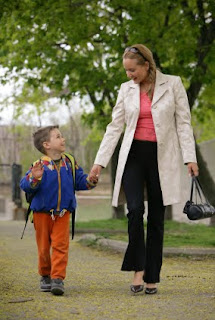Separation anxiety is a normal part of development in children, usually ranging from eight months to two years of age. Around eight months, a child begins to understand about object permanency. When a baby is not able to see an object in front of her, she believes it to have disappeared. It is therefore important to create a sense of trust and security so a child understands she is not being left alone. Attempts to leave the child alone, either with a caregiver or in their bed to go to sleep, are often met with anxiety and tears. Most children overcome this anxiety by age two, especially those who experience being left in the care of others for short periods of time.
The first day of school can bring about a re-occurrence of separation anxiety for some children. It is often caused by the fear of the unknown in a new situation. Parents’ attitudes as well, often play a deciding role in the child’s outlook and approach to starting school. Modeling appropriate behavior and attitude plays an important role in the success of the first day of school.
Dealing with Separation Anxiety at the Start of the Montessori School Year: Tips for Parents and Teachers
Tips for Parents- Create and establish peaceful (and happy) morning routines.
- Place “love notes” in your child’s lunchbox and a picture of her family in her backpack.
- Always say goodbye to your child and include a light hug and/or kiss. Tell her you’ll be back when school is out. Prolonged goodbyes are harder on both child and parent.
- Allow the teacher to assist her in the classroom.
- Stay positive and enthusiastic at drop off. Don’t cry!
- Don’t linger and peek through the classroom door or window.
- Don’t linger in the parking lot.
- Read books together about going to school.
- Be prompt at pick-up and turn off your cell phone so you can focus all your attention on your child.
- Greet children at the door, shaking hands and introducing yourself, welcoming her to your classroom.
- Do not allow parents into the classroom. Instead, have older children act as classroom ambassadors, welcoming younger classmates and showing them where to put their lunch, hang their backpack, and where the bathroom is.
- Have a prepared “first day of school” snack set out to welcome students. (Check beforehand regarding food allergies).
- Have transitional materials plainly visible near the door so children are greeted with familiar materials.
- Engage the child in meaningful work as soon as possible.
- First Day Jitters, by Julie Dannenberg
- Mouse’s First Day of School, by Lauren Thompson
As much as possible, NAMC’s web blog reflects the Montessori curriculum as provided in its teacher training programs. We realize and respect that Montessori schools are unique and may vary their schedules and offerings in accordance with the needs of their individual communities. We hope that our readers will find our articles useful and inspiring as a contribution to the global Montessori community.
© North American Montessori Center - originally posted in its entirety at Montessori Teacher Training on Thursday, August 20, 2009.
© North American Montessori Center - originally posted in its entirety at Montessori Teacher Training on Thursday, August 20, 2009.



0 comments:
Post a Comment
Have questions or comments? Let us know what you thought about this article!
We appreciate feedback and love to discuss with our readers further.